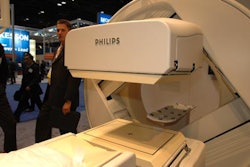CHICAGO - Multimodality vendor GE Healthcare of Chalfont St. Giles, U.K., is promoting enhancements for its CT and MRI technology in its booth at this week's RSNA show. The company is also promoting recent launches in its PACS and ultrasound divisions, as well as new clinical applications and research initiatives in molecular imaging.
CT
In the CT section of its booth, GE is highlighting LightSpeed VCT XT, the next generation of its flagship multislice CT platform. Also a 64-slice scanner, VCT features a variety of new hardware and software technologies, with a major emphasis on radiation dose reduction for cardiac imaging scans.
SnapShot Pulse is a cardiac imaging technique that reduces radiation dose by turning off the scanner's x-ray beam when the patient's heart is not in the optimal position for image acquisition. Called prospective triggered gating, GE believes the technique can reduce radiation dose by as much as 70% -- the company's clinical users have routinely performed cardiac studies at radiation doses of 3 mSv, and in one pediatric case the dose delivered was 0.7 mSv.
With SnapShot Pulse, the scanner works in step-and-shoot mode, an axial rather than helical scanning technique in which the system moves over the patient in five sequential steps, each time collecting an image of the heart at the same point in the cardiac cycle. There is also no image overlap as is common in helical studies, further reducing patient dose.
Another new CT technology is VolumeShuttle, designed to enable whole-organ anatomical and physiological assessment by doubling the coverage width of anatomy without increasing dose relative to a single axial acquisition with a single contrast injection. The technique can produce CT perfusion studies with 80 mm of coverage.
VCT XT will begin shipping in December on new systems, and will be made available to the installed base of VCT users in mid-2007, the company said.
In the works-in-progress area of the company's booth, GE discussed Volume Hi-Def, a new detector and reconstruction technology under development that the company hopes will produce up to 200% more voxels per cubic centimeter in CT images by ensuring that CT detector and focal spot sizes match. The technique could prove useful in various applications, such as by reducing the calcium "blooming" effect in cardiac CT studies, and could also lead to improvements in vessel tracking and better accuracy of stenosis measurement.
Another new work-in-progress technology on display is statistical iterative reconstruction, which is designed to reduce noise while improving image quality.
BrightSpeed Select is a new version of the company's BrightSpeed midrange product line that now comes in a more compact package. BrightSpeed Select includes many of the technologies found on the LightSpeed VCT systems, and comes in four-, eight-, and 16-slice models.
Finally, CT Perfusion 4 Neuro is a new software analysis package designed to aid in the assessment of changes to perfusion, blood volume, and capillary permeability, which may relate to stroke or tumor angiogenesis. The software is able to create perfusion maps with a single mouse click, and uses a new tool called tissue classification index for determining the status of tissue based on perfusion-related parameters during the first six hours after the onset of symptoms.
IT/PACS
GE is launching its Centricity Imaging RIS-IC, formerly known as Imagecast from IDX Systems, which GE acquired 10 months ago.
The rollout of Centricity Imaging RIS-IC is part of GE's campaign to extend its IT and PACS market reach from hospital radiology departments to community and rural hospitals and outpatient imaging centers.
Centricity Imaging RIS-IC is designed for simplified access to multiorganizational and multitime zone scheduling, multiple reporting options, outcome monitoring, and patient and image tracking to enhance workflow and productivity.
The features include closed-loop reporting, redundant data entry reduction, and embedded voice recognition. Integrated document management technology is designed to support paperless workflow, while the software's assisted patient matching module (APMM) helps to reduce medical errors through improved patient identification.
GE noted that the company had more than 80 PACS and more than 40 RIS installations go live this year. In 2007, GE is looking to add more functionality to its RIS and PACS to drive enhanced workflow from the technologies and integrating advanced applications on its workstations.
For example, GE's Centricity PACS combined with Centricity AW Suite 2.0 is designed to help clinicians sift through data-intensive procedures, optimizing workflow, image quality, application flexibility, without having to move to a separate workstation.
Women's healthcare
GE also rolled out the Senographe Essential, the next generation of its Senographe full-field digital mammography system first introduced at last year's RSNA show. One key feature of the system is a larger detector -- 24 x 31 cm. The device's digital detector is designed to deliver optimum detective quantum efficiency (DQE) at low doses.
The Senographe Essential launched this past summer after receiving U.S. Food and Drug Administration (FDA) clearance in April.
GE also is making the best of ultrasound and MRI in two products. The Sentinelle breast MR system combines Toronto-based Sentinelle Medical's Vanguard dedicated breast imaging and intervention patient table with GE's Signa HD 1.5T MRI scanner.
The open architecture design is intended for enhanced medial and lateral access to the breast for unimpeded imaging and intervention. Additional access to the breast in the anterior direction enables breast positioning similar to stereotactic mammography.
The Sentinelle breast MRI system is applicable for the detection of breast lesions, evaluation of treatment, and the surveillance of high-risk patients.
GE also has combined its 1.5-tesla MRI systems with Israeli focused-ultrasound developer InSightec and its ExAblate 2000. The MRI-focused ultrasound configuration is designed to noninvasively treat tumors, such as uterine fibroids.
The detachable ExAblate table is compatible with all GE 1.5-tesla MRI scanners, and GE is working to develop compatibility with 3-tesla magnets. The price tag for the combined system is approximately $1 million, depending on features.
MRI
In the MRI section of its booth, GE is highlighting the delivery of the 1,000th Signa HD scanner with the company's Propeller-HD technology, which reduces motion artifacts. Propeller-HD represents the third generation of the Propeller technology.
GE is also announcing the installation of an MR-guided intraoperative surgical suite at Barrow Neurological Institute at St. Joseph's Hospital and Medical Center in Phoenix.
In new clinical applications, GE is launching CartiGram, an optional application for the company's Signa HDx platform that allows clinicians to noninvasively visualize collagen fiber degradation. The application automatically generates color maps based on a scale of T2 values, allowing physicians to see changes in the composition of articular cartilage, in some cases before changes in the thickness can be seen.
In the realm of coil technology, Signa HD Head-Neck-Spine Array is a new radiofrequency coil that enables users to scan multiple neurology patients or perform a series of exams on a single patient without changing coils, leading to shorter exam times. The array features 29 elements and 16-channel outputs, and places the highest density of coil elements in the imaging field-of-view to maximize image quality, according to the company.
Ultrasound
Highlighting the ultrasound section of the company's booth, Voluson E8 is the newest version of the company's volumetric ultrasound scanning platform. First announced in October, the system includes a number of tools for improving clinical workflow, including sonography-based volume computer-aided diagnosis (SonoVCAD), which makes it easier to acquire volume images of the heart.
Voluson E8 also includes a new high-resolution transvaginal probe, a new matrix-array volume probe, GE's TruScan architecture that enables rapid access to saved images from a previous study, SonoErgonomics for enabling sonographers to adjust the system to their preferences, and ViewPoint, an ob/gyn patient data management system.
GE's Logiq 9 scanner comes the company's third generation of speckle reduction imaging in high definition (SRI-HD), designed to reduce the speckle inherent in ultrasound, creating more defined images. SRI-HD includes organ-specific imaging through a new process that images according to tissue type for better contrast resolution and border detection.
Logiq 9 also offers GE's proprietary tomographic ultrasound imaging (TUI) technology, which gives clinicians access to simultaneous views with adjustable thickness of multiple slices from a volume dataset, similar to MR and CT.
The portable Logiq P5 is GE's lower-end offering for radiology departments, private practices, and specialized clinics. The next-generation device also has HD-SRI, for greater visibility of organs and lesions and improved, high-definition contrast resolution.
CrossXBeam spatial compounding is designed to enhance tissue and border differentiation with an exclusive spatial compounding acquisition and processing technique. In addition, 4D imaging acquires 3D images in real-time to display anatomical details with stunning image clarity.
GE's drive for miniaturization within its ultrasound line continues with its laptop-sized Logiq i ultrasound system. The 10-lb Logic i has received FDA 510(k) clearance, but GE still regards the device as a work-in-progress, as the company adds more functionality. GE plans to begin marketing the system to radiology departments, community and rural clinics, and mobile imaging services in January 2007.
New tools on the 3.0 release of the company's LogiqWorks workstation include the ability to generate DICOM multiframes in the 3D volume cube or from the 4D dataset; and Multi-Vendor 3D, which reconstructs DICOM ultrasound multiframes into a 3D cube for quick volume ultrasound review, according to the company.
Molecular imaging
GE is touting recent additions to its SPECT and PET product line in the molecular imaging section of its booth.
The firm is promoting the next generation of its SPECT/CT hybrid system, Infinia Hawkeye 4, which combines the company's Infinia gamma camera with its four-slice CT scanner technology.
Infinia Hawkeye 4 produces 5-mm slices to match the SPECT resolution and acquisition conditions. Prime uses for Infinia Hawkeye 4 include advanced attenuation correction, tumor localization through advanced reconstruction, and treatment planning.
In the six months since its debut in June at the annual meeting of the Society of Nuclear Medicine, GE has shipped more than 70 Infinia Hawkeye 4 units. The hybrid SPECT/CT system carries a list price of $650,000, depending on configuration.
Infinia Hawkeye systems also integrate with GE's Xeleris workstations to enhance productivity using Ignite technology. The Xeleris workstation's features include processing speed, productivity tools, and built-in connectivity to various imaging systems to best serve PACS.
On the PET side, the company began shipping the 64-slice version of its PET/CT technology, Discover VCT, earlier this year. At the RSNA show, GE is introducing MotionFree, a technique for reducing motion artifacts during PET studies.
Because PET scans can take up to 10 minutes to acquire patient data, respiratory-related motion artifacts are a major issue. MotionFree compensates for patient breathing by acquiring 4D PET data and processing it in a way that basically freezes respiratory motion. The technique is shipping as part of a new release of the Dimension scanner console.
GE's FASTlab is making its first RSNA appearance after debuting earlier this year. FASTlab employs a single-use cassette that premeasures quantities of chemicals required for the synthesis of radiopharmaceuticals for PET radiopharmaceutical production. The production process takes approximately 23 minutes.
FASTlab -- which replaces its predecessor, Tracerlab -- also is designed to accommodate different chemistries, facilitating the production of multiple PET tracers. Users can change cassettes for another production run, while the previous cassette is cleaned.
The first application launched on the platform is the PET radiopharmaceutical fluorodeoxyglucose (FDG). In testing in the U.S. and Europe, the cassette produced batches of FDG with a mean uncorrected yield of 70%.
GE is planning to expand the utility of the platform by developing a range of other radiopharmaceuticals, including GE proprietary diagnostic imaging agents. FASTlab has a list price of $150,000.
In the realm of nuclear medicine software, GE also is debuting new applications. CardIQ Fusion is a specialized cardiac fusion application that brings together anatomical and physiological data from CT, PET, and SPECT images on GE's Advantage Workstation to allow multimodality analysis in a single application.
The first worldwide evaluation of CardIQ Fusion for both PET and SPECT currently is under way at University Hospital in Zurich in Switzerland, which was instrumental in the software's development.
Clinicians can use CardIQ Fusion to fuse CT anatomical data -- such as coronary angiography -- with PET- or SPECT-based physiological data, such as perfusion or viability, to evaluate cardiovascular disease. In addition, CardIQ Fusion allows users to review and analyze angiographic data from CT for stenosis detection, vessel analysis, and quantification.
GE also is demonstrating CardIQ Physio, a specialized cardiac application that allows clinicians to process PET dynamic or gated-dynamic data to export to more advanced academic analysis tools to perform myocardial blood flow analysis, such as coronary flow reserve.
With the software, clinicians can study physiological studies such as perfusion, viability, or dynamic studies with investigational radioisotopes. Clinicians also can use the application to review myocardial perfusion studies based on rubidium (Rb-82), ammonia (NH-13), and viability studies using F-18 FDG.
Cortex ID is designed to make PET brain studies easier to conduct by creating a new presentation of brain cases using stereotactic surface projections (SSPs), and compares images to a database of normals. Meanwhile, ACQC is an attenuation correction quality control technique.
GE is also announcing a number of research collaborations at the RSNA meeting. The company is working with the University of Pittsburgh in Pennsylvania on using fluorine-18-labeled Pittsburgh Compound B (F-18 PiB) to identify amyloid deposits in subjects with a diagnosis of Alzheimer's disease. GE says that early clinical trials are promising, and larger multisite trials will be started in early 2007.
GE also announced the launch of a clinical trial to assess a PET agent designed to track angiogenesis, which can accompany the growth of cancerous tumors. The molecule being studied in the trial is a radiolabeled small peptide in a configuration that allows high affinity binding of the peptide to specific integrin receptors, including αγβ3. Integrin receptors have limited tissue distribution, but have high levels of expression during tumor growth, invasion, and metastasis. The trial is currently enrolling patients at Hammersmith Hospital in London.
X-ray
In the x-ray section of its booth, GE is showing several new systems launched earlier this year in its Definium product family, including Definium AMX 700, which represents the migration of digital radiography to the mobile imaging segment. The system features a 16 x 16-inch panel.
Other products in the Definium product line include Definium 5000, a U-arm system that received FDA clearance a week before the RSNA show, and Definium 8000, a premium fixed-room unit.
On the interventional x-ray side, Innova 3131 is a biplane general-purpose angiography system that includes a 20 x 20-cm flat-panel detector for cardiology and electrophysiology applications. The system also has a 30 x 30-cm panel for general-purpose work.
In its RSNA booth, GE is promoting the integration of intravascular ultrasound guidance on the system thanks to its partnership with Volcano Therapeutics of Rancho Cordova, CA. Innova 3131 received FDA clearance in March.
By Brian Casey and Wayne Forrest
AuntMinnie.com staff writers
November 27, 2006
Copyright © 2006 AuntMinnie.com



















